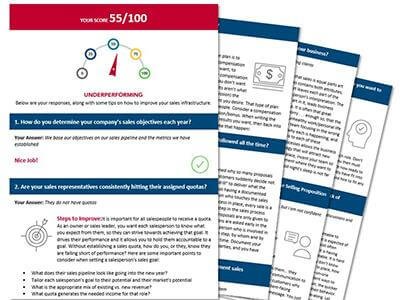Salespeople need to be measured differently than the rest of your organization because, unlike the rest of your staff, their performance is tied directly to the company’s revenue success. Your non-sales roles can wait a year to be formerly evaluated but waiting that long to conduct a deep dive on the developmental progress of your salespeople is a recipe for disaster.
Managing a high-performance sales team requires a lot more one-to-one coaching and development planning than other functions within the organization. That’s why highly effective sales managers don’t oversee large teams that can be common in other departments.
With so much riding on the performance of your salespeople, you need to be methodical in your leadership approach.
Not only do you need to ensure each salesperson is on track to hit their revenue goals, but you need to help
them get there.

As I wrote about in a previous article, How Can I Build an Accountable Sales Culture?, this involves developing a customized sales process, keeping stats and tracking progress, being an effective coach, and more.
When done right, salespeople look forward to their performance review because it’s designed to be a rewarding experience that guides them quarter-by-quarter to reach their revenue and personal goals.
Best Practice Sales Performance Review Structure
The first aspect in developing a productive sales review process is establishing its frequency. To enable your sellers, this shouldn’t be a once-a-year event but rather a quarterly building block process.
Implementing an effective sales review process can make a tremendous
and immediate impact on sales results!
This process shouldn’t be a burdensome undertaking for the sales manager. When it’s designed and operated properly, the manager and seller invest approximately 1-hour in preparation and 1-hour in productive discussion. Depending on time availability, you may want to substitute your routine 1-to-1 meetings with your salespeople to make room for the performance review. It’s important that you commit to keeping the quarterly review cycle on schedule. Consistency is key!
Adhering to a quarterly sales performance review cadence helps the sales leader and seller align in areas such as…
- What went right this past quarter?
- What are the top 3-5 priorities for focus to address identified gaps?
- Keep a pulse on short-term and long-term career goals
- Gain insight into how the manager may need to adjust resources or support
Next is developing the right performance categories for evaluation. Unlike the typical company-wide performance review form that includes three big picture questions, we want to take a more structured approach when reviewing salespeople.
evaluation. Unlike the typical company-wide performance review form that includes three big picture questions, we want to take a more structured approach when reviewing salespeople.
To continuously move the needle on an individual’s sales performance and their impact on sales and company culture, we can get at the heart of matter by focusing on these three evaluation categories:
1. Tangible Role Objectives – Sales Goal, Gross Margin Target, Key Performance
2. Will Do Attributes – Willingness to embody desired behavior, attitude, teamwork.
3. Can Do Skills – Ability to successfully perform required activities for success.
The subcategories that go under each of these evaluation areas should be custom to each sales organization and reflect key points of measurement that drive success in each unique sales role.
I like to have a series of measurement points under the Will Do and Can Do sections when I design Sales Performance Reviews for my clients. The objective is that they align tightly with the position description and its key accountabilities. Tangible Role measurements on the other hand are a short list that focus on the core performance metrics for the role.
Developing an unbiased scoring methodology that gets applied to each rating factor is also a key design strategy, along with weighting the impact of tangible role objectives heavier.
After all, even if a salesperson is performing swimmingly in Will Do and Can Do aspects of their position, if they are not achieving the stated revenue objectives of the role, there’s a big problem!
If you need help designing a high-impact Sales Performance Review approach, please feel welcome to reach out. This is a stand-alone high impact project that I enjoy fitting in amongst my full-scale Fractional VP Sales engagements.
Delivering a Rewarding Sales Review Experience
Now that you have a strong sales performance review track to run on, the next critical step is delivering a powerful review experience for your people.
The way you make that happen is by creating an open environment of sharing. During the review meeting you can afford to dig deeper to address gap areas that have only been lightly touched on during the normal course of business due to time limitations.

The idea is that once the sales performance review model is introduced, the data elements and evaluation areas become routine points of discussion between you and your salespeople on a day-to-day basis. There should be no surprises brought up during a performance review that catches the seller blindsided.
Instead, this is a time to partner with your people to help diagnose root cause of what’s causing undesirable results, behaviors, or skill gaps. This clarity is necessary to ensure the salesperson understands where the true problem lies and for you to confirm their willingness to focus on improvement. From there a plan can be established to overcome what’s holding them back.
It is also a time to recognize when misalignment may have occurred. For instance, a leader might rate someone as a poor communicator but after discussing the situation with the salesperson realize that the issue isn’t communication, but something relating to workstyle habits needing improvement.
If a salesperson is underperforming, now is when you want to invest yourself by partnering to figuring out ways to fix the problems. The salesperson should leave the meeting knowing what they need to focus on to improve and that you are committed to supporting their development.
Compensation Plan Renewal needs to be a Separate Focus
Contrary to what most people think, sales performance reviews should not involve discussion around compensation increases or adjustments. In fact, your compensation plan renewal process should be an entirely separate focus area for you as a sales leader. It should also be a separate discussion between you and your salespeople.
That said, referring to performance-based comp plan accelerators during the goal setting aspect of the sales performance review is impacting linkage. Our sales coach role calls for us to not only drive to achieve company revenue objectives but also guide the achievement of our sellers’ personal goals.
When it comes to high performers, their personal
goals almost always involve their desire to blow the
doors off their quota minimums!
Applying focus on your sellers’ personal goals and
career objectives is a critical aspect of the review
process given its tie to employee retention. This is
more important than ever as we live through periods of limited workforce availability.
If reviewing your sales comp plan is currently at the top of your list, check out a previous blog I wrote called, How to Drive The Right Sales Behavior With Your Compensation Plan . I suspect you’ll find some helpful design guidance in there.
Ongoing Sales Coaching is The Difference Maker
Done properly, your salesperson should come out of their performance review having created an action plan for the next relevant time period. Depending on the improvement areas identified, it could be a short-term monthly plan or something that spans over the next quarter or longer.
Based on how you see your salesperson progressing, you may recommend a book for them to read or find a training course that will help them conquer “Will Do” or “Can Do” struggle areas. Maybe shadowing another salesperson would be helpful or the implementation of a sales mentor program.
Whatever your approach, your role as a coach is to
continually check in on progress during routine 1-to-1 meetings and serve as a support agent.
In the event a shortcoming cannot be overcome, and employee separation is necessary, it should not
come as a surprise to the employee because you
provided clear awareness of what needed to change and a plan to get there.
Key Takeaways for Sales Performance Reviews
- Establish a quarterly standing review cadence.
- Assure understanding of what is to be measured and what good results look like.
- Identify root cause of performance gaps and partner with seller to develop action plans that have buy-in and committed timelines.
- Comprehensive goal setting goes beyond meeting a revenue target – it should include personal and professional development as well.
If you could use some help designing and implementing a high-impact sales review process, please feel welcome to reach out to me for assistance.
You can contact me through any of these methods: call me at (571) 329-4343, or email me at Chris@Salesgrowthadvisor.com , or book a call through my Scheduling Tool .

Another helpful resource I offer is a custom report you will receive after investing 2-minutes taking my SALES AGILITY ASSESSMENT
It’s filled with tips on how to optimize your sales environment based on your unique responses, making the report individualized and insightful!
—————————————————————————————————————————————–
I am part of a national group of Senior Sales Leaders who collaborate to share insights like the examples shown in this article. We formed because of our shared passion to help business leaders exponentially grow their revenue.
Chris Tully
President | Sales Growth Advisors LLC

(Phone) 571-329-4343
(Email) crtully@salesgrowthadvisor.com
(Schedule) Here is my calendar link!
(Web) www.salesgrowthadvisor.com
(Blog) https://www.salesgrowthadvisor.com/insight/blog/







Leave A Comment